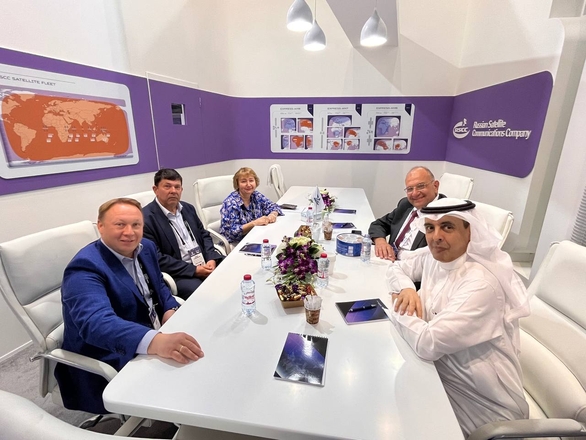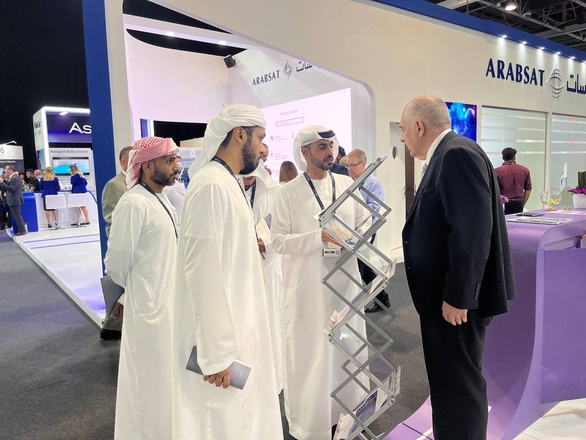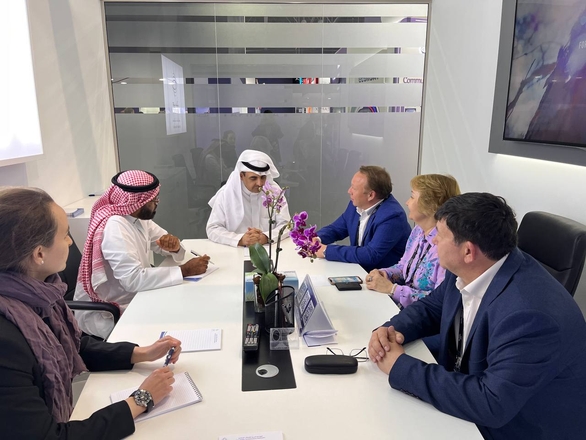The Oriental Rise: How Satellite Changes Middle East Digital Landscape
The space economy of the MENA (Middle East and North Africa) region stood at $469 bn in 2022, and was expected to exceed $1 tn by 2040. That was the estimation of the whole space sector (including the launch market, manufacturing, and commercial services) made at the Cabsat 2023 exhibition in Dubai. Global GSO operators see the MENA region as a priority market. In their turn, regional GSO players are experiencing competitive pressure from low-orbit (LEO) systems and trying to turn the table through optimal models of cooperation and by commissioning HTS with flexible payload. And national agencies of the region are planning to launch their own spacecrafts.
RSCC continues to develop foreign projects and has considerably expanded its footprint in the MENA region, providing competitive high-quality services in these countries. At the Cabsat 2023 event in Dubai, RSCC showcased the possibilities of its space constellation consisting of 12 satellites. Three of them, Express-AM8, Express-AM7 and Express-AM6, ensure the stable region coverage and are the perfect solution for corporate networks, television broadcasting, and marine connectivity.
During the three days of the Cabsat exhibition, RSCC achieved a number of agreements on the use of the company's space bandwidth for the provision of data services, communications, TV and radio broadcast. RSCC representatives talked on a wide variety of topics with the existing and prospective partners. This gives the company an opportunity to strengthen its leading position in space technologies and offer its clients the most innovative and reliable solutions.
The Cabsat event also hosted the SatExpo summit where chief executives of global satellite operators outlined the key trends of the industry. In particular, a lot of attention was paid to digital satellites with flexible payload. One year ago, in April 2022, Arabsat, one of the central participants of the exhibition, ordered Arabsat 7A, the first satellite with fully software-defined payload (PL), from Thales Alenia Space. Its Ku-band PL will be arranged in a multilink pattern with frequency repetition, allowing the operator to expand its business first of all on vertical markets. Today, the company's income from video and data transmission are split more or less equally. From following the market trends and looking towards data transmission orientation the operator is still hampered by the insufficient capacity suitable for that. Abdulhadi Alhassani, CEO of Arabsat, stated during the Cabsat about the high competitive pressure from LEO systems, while part of their declared capacity cannot be used efficiently because it works for non-inhabited areas. In early April, the operator's Badr-6 satellite failed, already at the end of its active life. Arabsat specialists transferred clients to other satellites, and after Badr-6 became operational, they chose not to get them back. The reason is that Badr-8 is scheduled to be launched in May, and all users will be transferred to the new satellite.
Another Middle Eastern operator, Yahsat, operates five spacecraft, with one more in the making. With the acquisition of Thuraya, the company entered the mobile communications and Internet of Things market. In order to be able to provide direct customer solutions, Yahsat acquired a stake in IoT technology developer eSAT Global. And in 2024, after the commissioning of Thuraya 4-NGS, the operator is planning to scale up its activity on the IoT market. The acquisition of Thuraya gave Yahsat frequency bandwidth in the L-band, which makes the company an attractive partner to join direct satellite mobile communication projects. And, according to the company's chief executive officer Ali Al Hashemi, this can become a good basis for consolidation.
Yahsat aims to create an integrated structure. Beside the classic satellite business (video and data transmission, broadband access) and innovative services (satellite Internet of Things, direct mobile communications via satellite), the operator is intending to provide Earth remote sensing (ERS) services. This project is being implemented jointly with the UAE state agency. Yahsat has signed an agreement with MBRSC, under which it will provide its clients with ERS data collected by the agency. As declared, this project is just the first step to the creation of a sovereign space economy of the country.
It is expected that by 2027 the demand for ERS data will exceed $100 mn in UAE and $400 mn in the entire MENA region. The global market potential is estimated to be over $4 bn, including the data in all bands.
Other regional operators
The Azerbaijani satellite operator, Azercosmos, was also represented at the exhibition. It recently signed a cooperation agreement for long-term projects with CommCarrier Satellite Services Limited, a satellite service provider in the Republic of Kenya. CommCarrier will use the Ku-band of the Azerspace-2 satellite for the servicing of its clients in the Eastern and Central Africa. Omani Space Communication Technologies, an operator from Oman, declared a tender in 2021 for the manufacture and launch of Omansat-1 satellite. However, no further information has been given on how project is going.
Global players in MENA lose no ground
SES got a loan of €300 mn in January 2023 to finance three digital satellites for the servicing on Europe, Africa, and Middle East. The launch is scheduled already for 2024. This is what the operator said during the SATEXPO summit at the Cansat exhibition. In the autumn of 2022, the operator launched for Europe and MENA a specialized satellite platform working in the DVBS2x standard for the transmission of live casts of sporting events, concerts and other events.
What is even more interesting is that in late 2022 and early 2023, SES, in alliance with UAE mobile operator Emirates Integrated Tele Communications Company (EITC), conducted a demonstration of the capabilities of the 5G satellite transit network in the Middle East. The transit network was functioning via a middle-orbit constellation, which ensured small latency of the signal in the network.
To demonstrate the concept in real time, multiple tests were made on the SES O3b satellite, voice and data transmissions were conducted, multiple measurements of the service quality were made, as well as stress tests to check how the network would perform in higher load conditions.
One more global player, Eutelsat, has always seen this region as one of its priorities; the operator's constellation at 13°E has always had a good coverage of the Middle East and North Africa. In 2023, the Hotbird 13F, which was launched in October 2022, came operational in that point. Built by Airbus Defence and Space within the framework of the Neosat partnership project of the European Space Agency (ESA) on the basis of the Eurostar Neo platform, it boasts greater energy performance. Hotbird 13F is the first of the two crafts that will replace the existing three Hotbird satellites at 13°E.
But, while HotBird is traditionally focused on video transmission and direct TV broadcasting, for the broadband services Eutelsat is implementing the Konnect program using its own HTS. In June 2022, the operator joined the Partner2Connect coalition of the International Telecommunication Union (ITU) and took the obligations to provide broadband connectivity for more than 1 mn people in Sub-Saharan Africa by 2027. Half a month later, Eutelsat declared that over 200k users had been already connected via its Wi-Fi Konnect hot spots.
Intelsat is more aiming at the vertical markets and at the mobile communications market. In the beginning of the last year, the operator ordered from Thales Alenia Space two software-defined satellites for the support of the global 5G network: Intelsat 41 (IS-41) and Intelsat 44 (IS-44). They will provide dynamically distributed communications in Africa, Europe, Asia, and the Middle East. The launch is scheduled for 2025.
Last March, Intelsat expanded its agreement with Eutelsat, concluded back in 2019 by Gogo Commercial Aviation, when the company was not part of Intelsat yet. The seven-year agreement includes also the utilization of geostationary satellites (Eutelsat 10B, Eutelsat 172B and Flexsat), and OneWeb spacecraft. Using their capacity, Intelsat will offer mobile communications services in air, land and sea in Europe, in the Middle East, and in the Asia Pacific region.
New wave operators
The trend of direct satellite mobile communication developed has not bypassed this region, either. AST SpaceMobile, one of the startups that develops this service and launches its own constellation of 'space base stations', has signed a memorandum of understanding with Zain KSA operator from the Saudi Arabia. It will help the companies begin the development of joint telecommunications solutions as well as satellite digital services in Saudi Arabia and the entire region.
The joint venture between the global operator OneWeb and the Saudi Arabian company Neom has also paid off. Relationships have been established with suppliers of digital and telecommunications solutions in Egypt and other countries of Africa and Middle East. The first big telecommunications group to cooperate with OneWeb is Benya Group.
In general, the same trends are manifesting in the MENA region as on the global market. These are:
- using HTS with flexible load to compete with other technologies;
- fitting the satellite into the 5G infrastructure as an integral element of it;
- the main driver is still the transmission of video via GSO spacecraft (since OTT services are developing not that rapidly).
Low-orbit systems are more focused on B2B, mostly operator market, because private users in the region, as a rule, have got no money to buy individual terminal units. And the influence of GSO operators is still high.




